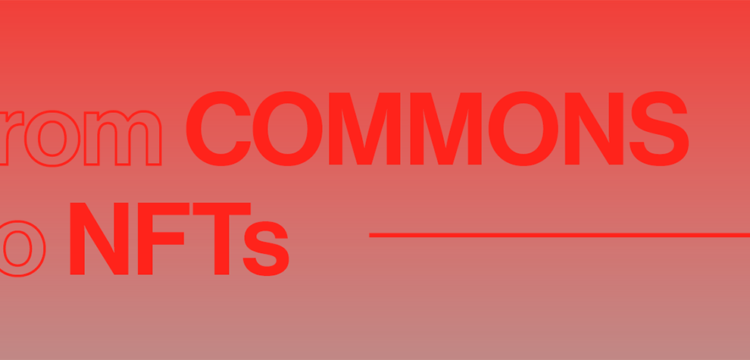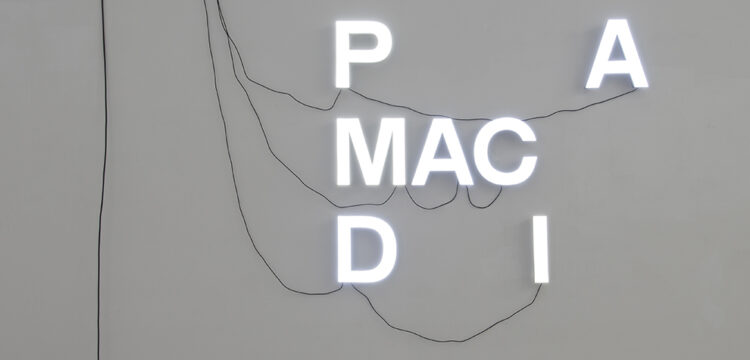Browsing bottom-up alternatives for Art on Web3
A conversation with Andrea Baronchelli, María Paula Fernández, Domenico Quaranta, and Ryder Ripps
What follows is an abbreviated account of the homonimous roundtable hosted by the Uzbekistan National Pavilion at La Biennale di Venezia on October 22, 2022, organized and moderated by Silvia Dal Dosso and Giacomo Scandolara, among the founding members of the superinternet.world, “a poorly made bottom up anti-Metaverse, where users can be not-sad, or at least not exploited, by design”.
The complete recording is available online, kindly provided by the Art and Culture Development Foundation under the Ministry of Culture of the Republic of Uzbekistan and the Giga Design Studio.
NFT technology has, on one hand, allowed digital art to get more relevance within the art market and get valued and monetized in new ways; on the other, it has indelibly destabilized digital communities, dragging artists into exhausting Ponzi schemes, to eventually leave them facing a depressing spectacle of rankings, speculation and crashes. Meanwhile on Web3, the construction of hypercapitalized social spaces relentlessly proceeds, waiting for the kids to be too old to hang on Fortnite… Yet, the eternal struggle over technological dominance goes on. In spite of the challenges, more aware NFT projects are glimpsing under the ashes of the Terra-Luna crisis and the subsequent negative events that affected both the general crypto markets and the NFT ecosystem: NFTs are being adopted as a conceptual art medium, people are building alternatives to the anticlimactic market, while questioning the laws and nature of NFT and metaverses. Should we join the game, or should we crash our phones into the ground instead?
Starting from this question, we gathered in the beautiful location of the The Uzbekistan National Pavilion at La Biennale di Venezia, with Andrea Baronchelli, professor at City University of London, Token Economy theme lead at The Alan Turing Institute, and author of Mapping the NFT Revolution: market trends, trade networks, and visual features, Domenico Quaranta, art critic, curator and educator, author of Surfing with Satoshi, Maria Paula Fernández, co-founder of Juried Protocol Galleries (JPG.space) and the Department of Decentralization, and Ryder Ripps, conceptual artist and creative director, creator of RR/BAYC.
While the artwork that surrounded us, Dixit Algorizmi: The Garden of Knowledge by the architecture and research studio Space Caviar, may have looked as a Metaverse made flesh, instead it worked as a reminder that “gatherings and exchanges” need a suitable design to function.
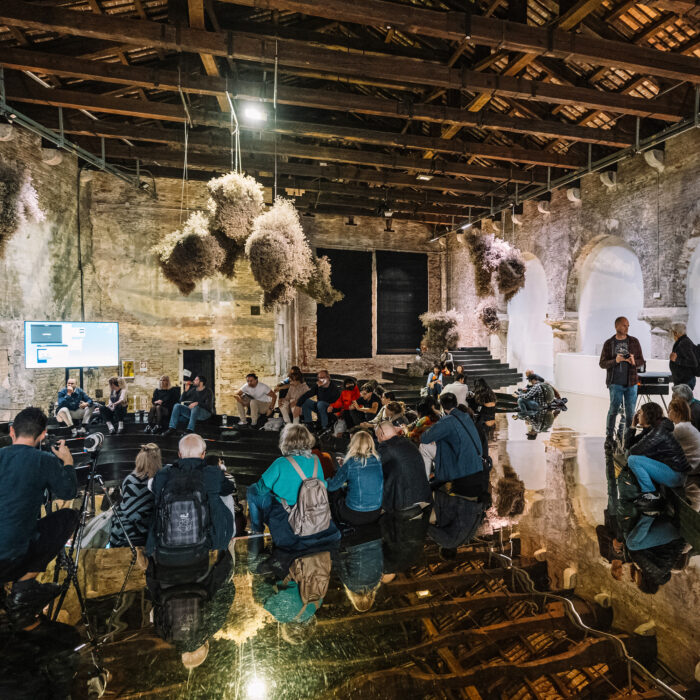
As Matthew Ball speculated in his now way too famous article The Metaverse: What It Is, Where to Find it, and Who Will Build It, Web3 will be powered by very expensive infrastructures. Something that only a few companies in the World will be able to financially support and therefore to design. What programmers, scholars, curators and artists in the digital sphere, the creative class, and ultimately the online millions are wondering today is whether to boycott this new technological proposal outright or to take part in the dialogue. In this scenario, any kind of account, experience or case study may be useful to understand how and whether it is possible to give a meaningful contribution to the construction of a web that does not depend on the sales and profit logics of a few, but on the desire to build spaces suitable for exchange and network building.
Andrea Baronchelli, together with the founder and director of the Visual Artificial Intelligence Lab at IBM Research Mauro Martino and other colleagues, most recently co-published the paper Mapping the NFT revolution: market trends, trade networks, and visual features. In November 2021, many were still confused on the nature of NFT, and the paper received widespread attention, reaching 151k accesses and providing a detailed data-driven picture of what was actually happening during the “NFT Craze”.
Andrea Baronchelli: I’m a physicist and I study complex social systems so, in general, I’m very interested in how disintermediating technologies affects our behavior. We already have seen what happened with Social Networks that disintermediate information, production and consumption. The blockchain attracted my attention a few years ago as a technology that disintermediates the creation and consumption of value. With my team I started studying it just a bit before CryptoKitties came out. Please consider that the CryptoKitties hype at the time was referred to in the press as the visible proof that the crypto world was populated by mad people. After this brief interlude of madness happened around 2017, the crypto winter arrived and things went slowly for a bit.
It was in 2021 when NFT came back as a tool that offered many desirable features for online creators. So we set up with my team of collaborators to harvest all the data that we could: we were able to gather data concerning 6.1 million trades of 4.7 million NFTs between June 23, 2017 and April 27, 2021, obtained primarily from Ethereum and WAX blockchains. As the paper title suggests, we started to map what was happening.
The vulgata that this “new” tech will break the world of galleries and reach the buyers immediately was true for a few weeks perhaps, but then the usual problem characterizing the economy of attention emerged. What then happened was that the explosion in the offering created a problem at the level of demand: if you put an NFT on Open Sea, which suddenly became a large market with millions of works and collections, the chance that you sell your work is approximately near to 0, if you do not accompany your drop with a massive marketing enterprise.
We were able to map the network of buyers and vendors. What we did realize was that the top 10% of the traders made 85% of the trades, and traded (at least once) the 97% of the NFT. This looked a lot more like a vertical distribution of markets and exchanges. Not a horizontally distributed one. We are very good as species in creating this unequal situation, characterized by wealth accumulation and gate keeping.
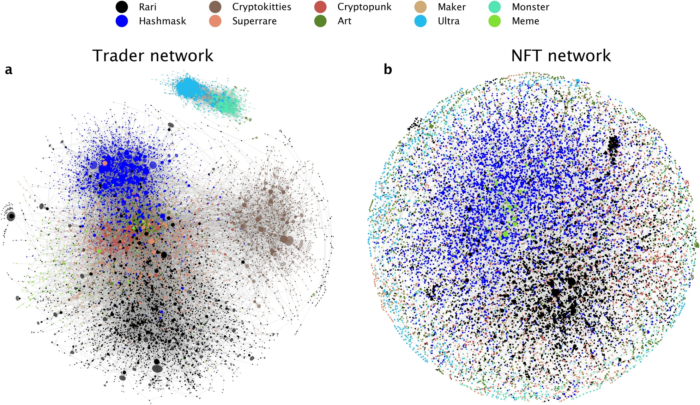
What we also observed is that most of the trades concentrated on the rare pieces of the most popular collections, like CryptoPunks and Bored Yacht Ape Club (BAYC from now on), so on the NFTs that presented “rare traits”, while art was not as highly regarded, as it seemed in the press. The problem of curating this huge amount of content has also completely broken the idea of the horizontal market.
Now we are in an NFT winter. The transactions in September were 95% less than previously. But this has happened for cryptocurrencies many times. Of course, with NFTs all could be different. We still do not know what happens with a crisis that affects something that is non fungible. Some collections or markets may lose importance, other practices may raise the attention. What we observe is that NFTs are maturing in other sectors. In the gaming industry right now they are a real and consistent part of the economy.
This gives us a very good introduction to the actual scenario, and certainly reveals to us who were the most prominent market players in NFT and Web3 at the time of their peak, from 2020 to 2021. Beyond crypto bumps and winter times, what we can observe is that this sudden spike in attention in digital creations brought an equally unexpected revolution in the art world, and when we say revolution we are unfortunately not referring to the rise-of-the-working-class meaning of the word.
For those who follow net art and media art (better not use the word digital art because he hates it) Domenico Quaranta has been a kind of international guru since 2006 with the publication of Gamescenes: Art in the Age of Videogames, written with Matteo Bittanti. He is connected with many artists that used to operate on the Web 1.0, a theme that emerged in his most recent exhibition The Byzantine Generals Problem. In the curatorial text of the exhibition, Domenico poses a series of questions on what is Web3, listing a series of contradictions that we are facing in the actual present: “An alternative to capitalism, or capitalism at its worst? An emancipatory network economy where everyone has a stake, or a dystopian panopticon where only the best man wins? An opportunity for democracy, or a techno-libertarian wet dream? A new creative economy or a pyramid scheme? A planet saver or a planet burner?”
Domenico Quaranta: I would like to start by clarifying why I don’t like the digital art label. This label creates an artificial grouping of things that do not have anything in common with each other, and it sets an inaccurate separation between what is digital and what is not, while at this point of history many things often tend to be both. I think it is interesting that right now we are finding again the need of talking about digital art. It was one of those labels that until 2020 were out of the game – people were talking about post media art, new media art and so on – and it’s exactly the economy around NFT that brought this label again into prominence, to describe the production of a very diverse community which creatively engages with digital tools and wants to generate a digital-only market around it.
I’ve often been critical about the biases and implications of NFTs, yet today I would like to bring a positive example in the use of the NFT technology. Yesterday Casey REAS, the co-creator of Processing, was turning 50 and on the occasion of his birthday he decided to make a mint and a live minting party.
In the past months he created a project called CENTURY, a generative code that reflects upon the abstract aesthetic of the XX century and offers a speculation about time and duration. Yesterday, for his birthday, he decided to make a new version of CENTURY called CENTURY 2052. He is 50, so he is wondering if he will see 2052. The artwork will “die” or be burned in the wallet of the buyers when Casey will turn 80. Will he outlive the artwork? Or will the artwork outlive him? This was a very intimate project – he didn’t sell the NFTs but donated them instead to a small number of people that were invited to the online party.
Why am I talking about this? As said, there are many downsides in the Web3 economy and model. In my book Surfing with Satoshi I’m very critical about some topics concerning the fabrication of abstract scarcity in the digital environment and copyright related issues. But in the meantime, what I keep seeing today, for example with Casey REAS, is that Web3 can also be a gift economy that employs the infrastructure of the blockchain in order to donate and not to sell. Who is owning the piece is emotionally attached to the artist. Those in the group might sell the CENTURY’s NFT and generate a market that may benefit Casey, but maybe they won’t sell it because owning it means that they are fond of that piece. Depending on the blockchain infrastructure, questions also raise. Will the very infrastructure that makes the life of this token possible outlive Casey, or will it last just for the next two or three years? And here I’m talking about the blockchain, but I’m also talking about the platform that is hosting the token, which is called ArtBlocks.
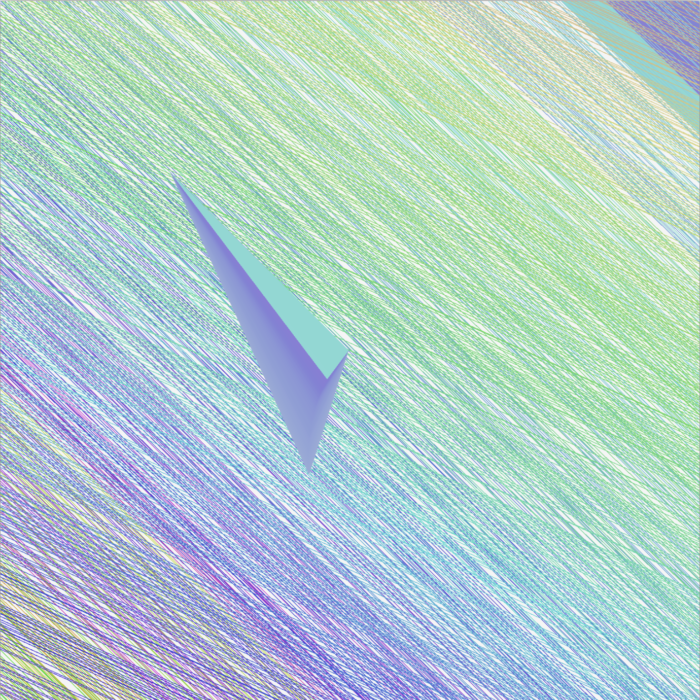
I myself own a small collection of NFTs. I’ve never been a collector, I’ve always been an avid downloader of things that are available for free online. I keep downloading things that are available online because it’s part of the economy of the web, but I also started using some little money that I have to buy digital artworks and to support the artists behind them. I’m buying to keep these tokens, not to sell them. I’m not interested in their economic value, most of them have 100 € of value, probably some of them even less, but I’m saying this because the Web3 economy has been shaped mainly by speculators. That was the driving force that made some people rich and some people poor but what is strong here is the possibility to join the game and to join it critically.
A few months ago I curated an online exhibition titled The Byzantine Generals Problem, referring to a problem of consensus that belongs to game theory. The solution to this problem is actually what made the blockchain so strong from a tech point of view. In the notorious anecdote, a group of generals seizing Byzantium without any authority above them have to agree on a final decision: attack or retreat? How can they reach a consensus without a reliable communication protocol between them? Solving this problem means finding a way to agree and to fight against the traitor, the general that may take a different decision.
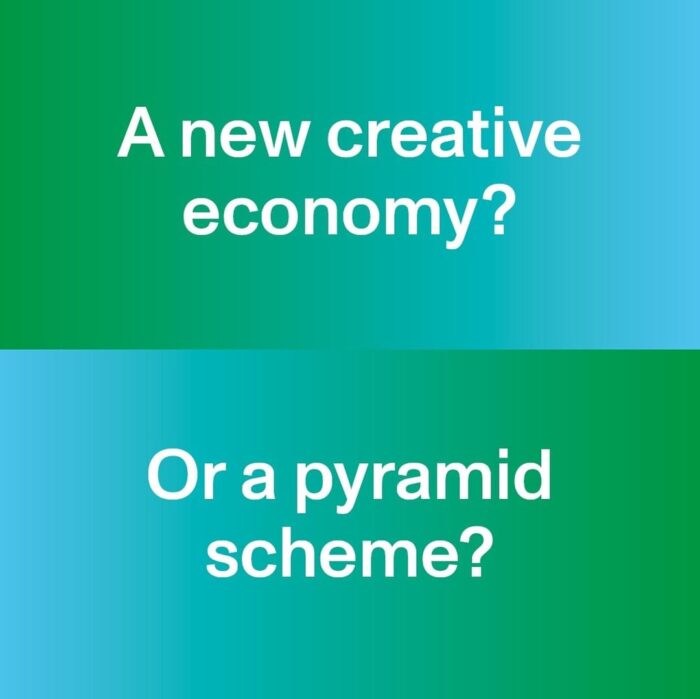
I think that the traitor, the disagreeing general, is a very powerful metaphor for the role that people and artists should take within the environment of the blockchain. This tech has been around since 2008-2009, it has been designed quite well but it’s really something that can be shaped and designed by hackers and programmers. There are people that believe in the blockchain as the ultimate dream for capitalism and there are others that consider it as an instrument to destroy capitalism, and both these people are currently shaping the blockchain and the dynamics around it. I do think that we have to contribute to this ongoing conversation, not only with programming but also with art and so on, in enforcing what can be used beneath this tech as community generation and governance.
And as you think that a contribution is more than necessary, let’s continue the conversation with two of the people that are largely contributing to the shaping of these dynamics, María Paula Fernández and Ryder Ripps.
María Paula Fernández is co-founder of an NFT decentralized platform for curators and creators called jpg.space and founder at the Department of Decentralization (DoD). She is from Argentina and she arrived in Berlin in 2013. For those who don’t know, Berlin in 2013-2015 was THE place for many things but also for a great crypto community which privileged decentralization and open source over mere speculations. Together with Hito Steyerl, she recently developed a very interesting art project on distributed democracies called StrikeDAO.
María Paula Fernández: Thank you for the invitation and for the great interventions. Talking inside an artwork (where we’re currently sitting) is really special. I come from Argentina but I’ve been living in Berlin, which has historically been one of the epicenters for the experimentation between blockchain and art. I do a bunch of different things, but my main two things are that in 2018 I founded the Department Of Decentralization (DoD), with the aim of exploring the intersection between hacker culture, Berlin culture and art. We organized hackathons, and also have written a few papers on the topic: There is no Such Thing as Blockchain Art (2019) and Wanderer Above a Sea of FUD: Cultural workforce, crypto anarchism, intellectual rights, and blockchain-based funding models for culture and arts (2021). While writing the second paper, we realized that something was moving, the market and the communities were growing very rapidly. I’ve been into NFT since 2018 (since everyone was very weird). We all thought that it was demented, but I felt something bubbling, as when water is about to boil. After publishing it, the 2021 boom started and Web3 hit mainstream thanks to the most unexpected use-case, NFTs.
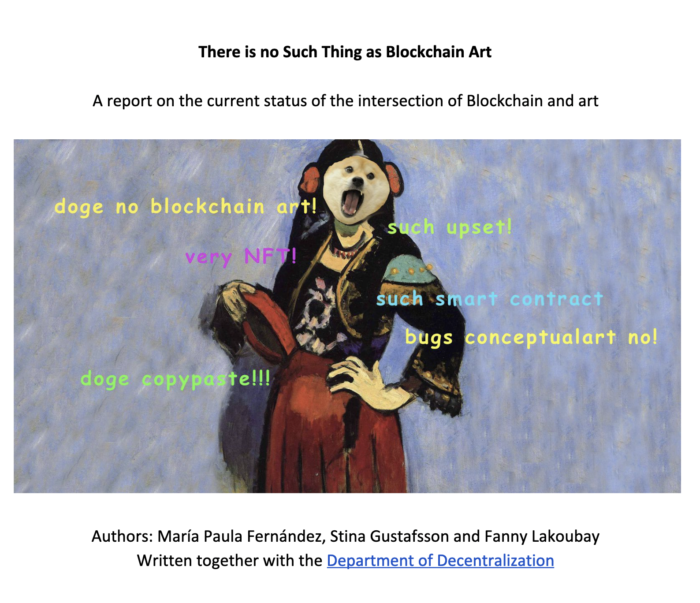
I would like to point out that the blockchain is much larger than NFTs and the Metaverse. The technology is able to create decentralized infrastructures, protect your data, give you back control of your finances, give you alternative systems of governance, and then there are also of course, cryptocurrencies. Coming from Argentina, I’m very interested in alternative systems, and this includes alternative financial systems. Anil Dash and the artist Kevin McCoy stated in 2016 “Currency is the least interesting thing you could build with this technology”, a sentence that comes from a Seven on Seven meetup, where actually one of the first NFT prototypes was born, and this still holds true in my opinion. It’s all about the systems, not about the currencies.
In relation to NFTs, I started a company with some collaborators called Juried Protocol Galleries LTD (JPG), but I will talk about this later. For the moment, I would like to bring a happy and speculative example of this technology used for collective decision making. This past year, we presented with DoD a project with Hito Steyerl. We took over the ENS Ethereum domain of the Bundeskunsthalle, a national art hall in Bohn, and speculatively enacted a situation in which the Bunderkunsthalle belonged to us. We had people presenting different alternatives for the governance of the Bunderkunsthalle. In order for a model to win, people had to vote using an app that proposed a quadratic voting scheme, and we had people voting for 3 different governance proposals. The proposal that won was based on the assumption that “since the BKH is funded by the taxpayers, so all the taxpayers are stakeholders and should be able to make decisions of the art that is included in the program at the BKH”. I find that this can be a great example on how to discuss the way institutions are governed and how to build inclusive infrastructure.
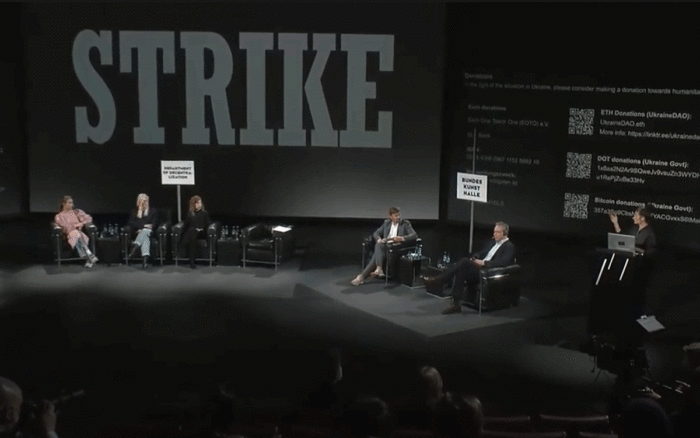
Going back to NFTs, at JPG.space we are very concerned with the overflow of these tokens, as we have seen this before with the problem of information curation on the internet, where it’s already overflowing and hard to manage. For instance, in spaces like Wikipedia, unfortunately this often results in a situation in which a few wrong people can own the tools, and determine the hierarchy, value and veracity of the content. Accumulation of assets by a few is also present in the NFT ecosystem. As Andrea Baronchelli was observing, this problem is very visible already. At JPG we want to try our best to democratize the access to neutral cultural infrastructure and tools: information wants to be free, not to be used as “alpha”.
The NFT space lacks proper indexing and, therefore, curation and discovery become quite difficult, combined with the issue of not having the dedicated infrastructure to perform these activities, that usually take place on Twitter, or in chunky metaverses that are not that easy to find or access. Oftentimes, the people curating are the same that own the NFTs, and use all their means to create marketing for them and grow the assets market. JPG is trying to build decentralized, neutral and open infrastructure for Web3 cultural objects. While doing so, we also create space for dialogue between artists, curators, institutions and communities. Without dialogue between the aforementioned stakeholders, it’s not possible to build something useful and grow it sustainably. I find JPG’s and my ethos around democratization and access close to the collaborative anti-metaverse that you guys are building, the superinternet.world.
And talking of trying to shape the community governance, the precise meaning and even, to some extent, the legal procedures related to NFTs, there is perhaps no better person than Ryder Ripps. Ryder is a conceptual artist, programmer and creative director, but also, at least for us internet kids, he is a legend. He created the meme “Thug Life”, and as creative director of OKFocus he worked along brands and musicians like James Blake, Grimes, Gucci, Marvel, and allegedly for CIA itself. He most recently developed a series of artwork pieces that are all kind of related to the same big topic, speaking against the big NFT monopoly of Larva Labs at first and of Yuga Labs later on, the people behind the two NFT major collections, CryptoPunks and BYAC.
Ryder Ripps: Related to the NFT Craze, I’ve been thinking a lot about the scam that went on with the giant inflated business called WeWork, started by a guy called Adam Newman. I was thinking about how there are parallels between the NFT industry, how it inflated and what the promise might be. The nature of culture and interests is cyclical. Adam started WeWork with the idea of being an Israeli Kibbutz, which is an older idea, and applied it to the New York psychology. We often wander around going back to the primitive origins or a weird version of it. Which is also maybe what is happening with NFT.
In my work I try to create provocations that will illuminate truths, and especially so in my work about blockchain. I think it’s important to understand where blockchain came from. As María was saying, NFT was conceived during a Seven on Seven conference, which happened in 2014. I was actually in the audience of the conference. As you can see from a slide from that meetup, it really lays out the purpose of the NFT: “Verification and Provenance”. These would allow to support and empower artists without artificially constraining access. An idea which is a tenant of Bitcoin and blockchain itself: maintaining universal access and making the data egalitarian.
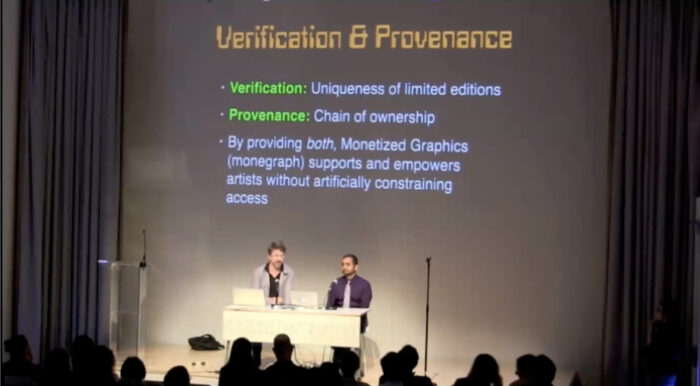
A project that I recently came across, and that relates to my work related to NFT, even if I didn’t know about it when I started, is the one of Nili Lerner. She created a new token, the NILIcoin, on top of the Bitcoin blockchain. She used a system called counterparty that allows users to create altcoins on top of Bitcoin. She created these new coins which were Coca-Cola, Apple coin, Ebay Coin. The idea was to create a provocation on intellectual property and the nature of how blockchain is a self regulating system that is sort of outside corporate power and control. This project came out just a few months before the advent of NFT, and its conceptual base is still relevant today. I don’t think we moved or established the complicated problems raised by NILIcoins.
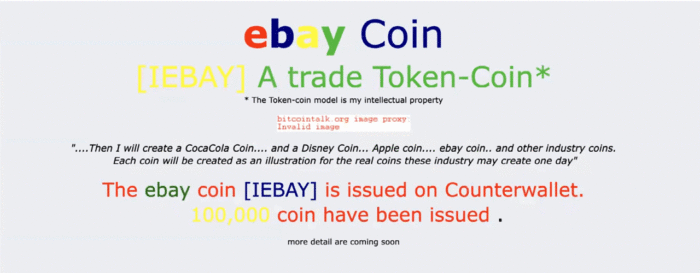
excerpt from Ryder Ripps’s
presentation.
The blockchain around 2014 was this place of radical commercialization and blatant bullshit. They had scams on top of scams, tokens on Ethereum blockchain particularly, that promised ridiculous things, for example IATA Coin, a token that would revolutionize air travel. Obviously, IATA Coin did not work out although the token garnered billions of dollars. This other token from TE-FOOD was another token that was offering a solution of traceability in food products via blockchain. Why do you need a token to do that? Most of these companies at the time had white papers that, if you read it know, seem almost conceptual art. They are completely full of fluff and they seem to be written on Adderall.
The next step has been the tokenization of bullshit through NFT. Axie Infinity is a good example of it, that did pretty well commercially. But it wasn’t until CryptoPunks that the real commercial viability and internet in NFT started. It is interesting to notice that with CryptoPunks the totality of the collection resides in one single image: when you buy a token you are buying the positioning in one single image. Which is an interesting implication of what an NFT is, because when you buy a CryptoPunks in fact you are certainly not buying an image.
Going back to the fluff and the scams, it is also interesting to observe that Larva Labs founders of course had lied by saying that this was the first NFT project, a statement which is kind of ridiculous for the people that, like myself, were in the audience at Rhizome’s Seven on Seven and witnessed the first NFT being created, or to people which understand that there is much more history related to digital art and in particularly to digital art on the internet and digital art on blockchain. Going backward through the Internet Archive we can see that on their OpenSea page they used to state themself as “the first NFT”, which is a lie.
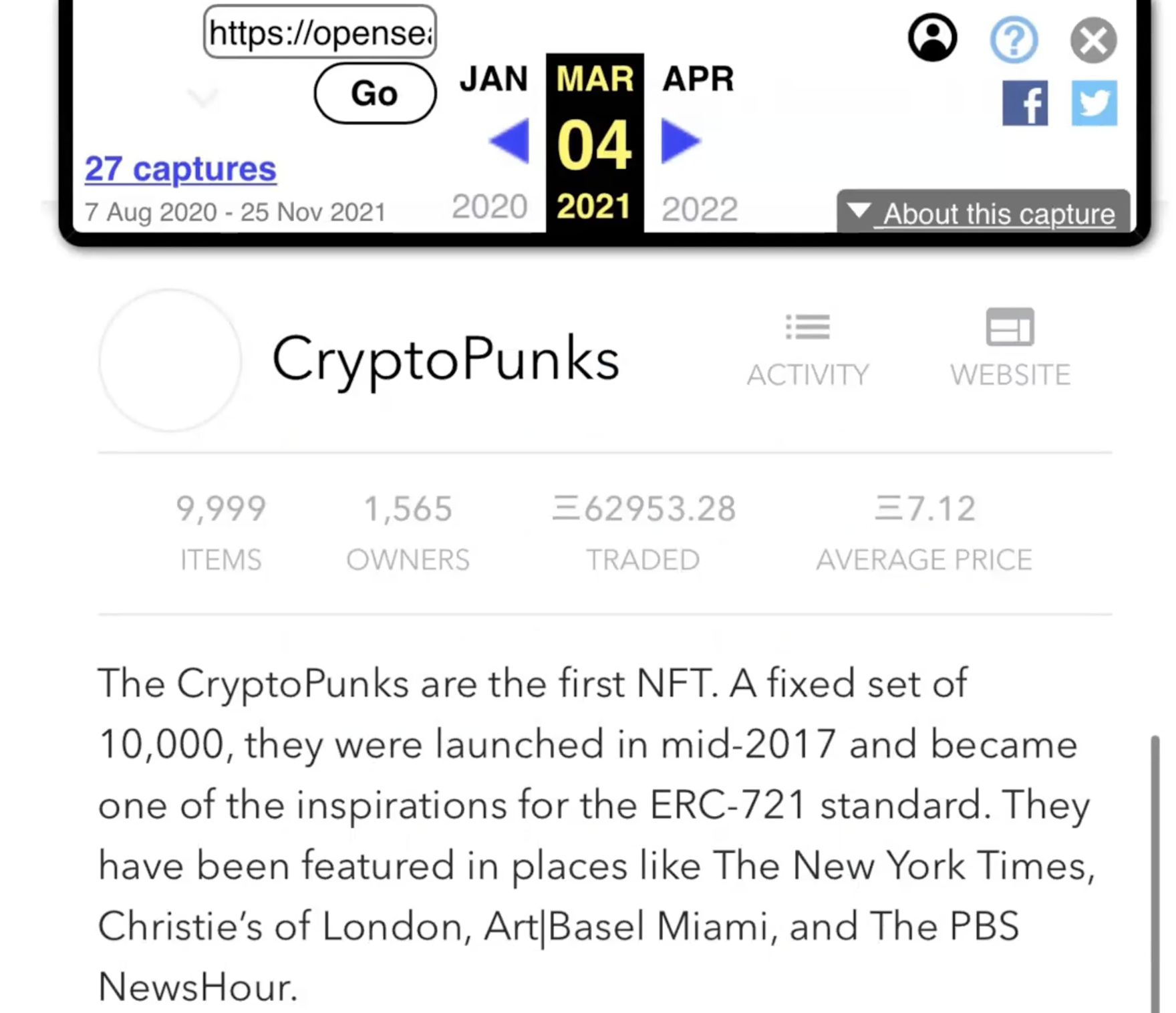
If you do some research you see that CryptoPunks at the beginning were not going extremely well by today’s standards. They were selling on average for 50 dollars and not for 10,000 or 100,000 or 1 million dollars, as we have witnessed later on. From my research, the catalyst that brought them to the scope of “major asset class” was Gary Vee buying fifty of them and then doing a phone call with business leaders and influencers in tech. I found a video where Mr. Beast is describing the phone calls he had with Gary Vee. It is interesting how everything is online and how you can actually trace back the start of this. When Gary Vee started promoting these things it brought attention to the NFT market in an unprecedented way. It’s interesting to think about Gary Vee as a person: he is more of a business leader and motivator, his frame is business and not art. This is extremely important to understand the entirety of the market froth, and to see NFT in this light. This move from Gary Vee really set the stage for the next 2 years in the NFT market. I see some parallel between the vape economy and vaporware and just vapor in general and the idea of technologies creating vapor and the proliferation of vaping in conjunction with NFT. It is important to think about all of this as vapor.
CryptoPunks were not the first NFTs and people that had no understanding of the rich history of digital art were the ones who started the hype around it. So I decided to create provocations around it. My first provocation was on CryptoPunk 3100 that at the time had been sold for 7 million dollars, and the buyer of it was trying to sell it again for 91 million dollars. So, I took the image and I just minted it myself. I didn’t think this was so much of a bigger deal, but this created a lot of buzz. People couldn’t even understand how I could have done it. Their understanding of NFT was so rudimental that they couldn’t even get that one could take an image and re-mint it.
An NFT influencer called Farook sent my piece to Jason Williams, a prominent Bitcoin influencer and thinker, who ended up buying it. As Farook was asking me if I was selling a “one to one replica”, I had to answer him that of course I wasn’t: the token has no purpose if it’s divorced from the idea of who made it, when and why they make it. Quoting from the chat I had with Farook: “The punk promise of Cryptocurrency to be free from nation state and with privacy standards seems to be idealistic in an age of highly regulated monopolized exchanges and NFTs where “provenance” is established through connecting a wallet to a person. My resale of Cryptopunk #3100 is newer, more human, and has more meaning and is more punk then the Larva Labs LLC thing”.
My provocation created a public issue on Twitter. What should Larva Lab do? They sent me a DMCA takedown notice. I minted that of course and became part of the piece. It is ridiculous to send a DMCA alleging that I copied the NFT when in fact it is impossible to copy an NFT and this is the entire point of the NFT token. I replied by sending a counter argument stating that this was within the parameters of fair use. And with this I basically challenged them to sue me, and of course they didn’t. From their part it was legally impossible to build a case around it. Also, in their behaviors, they showed a very centralized approach to blockchain.
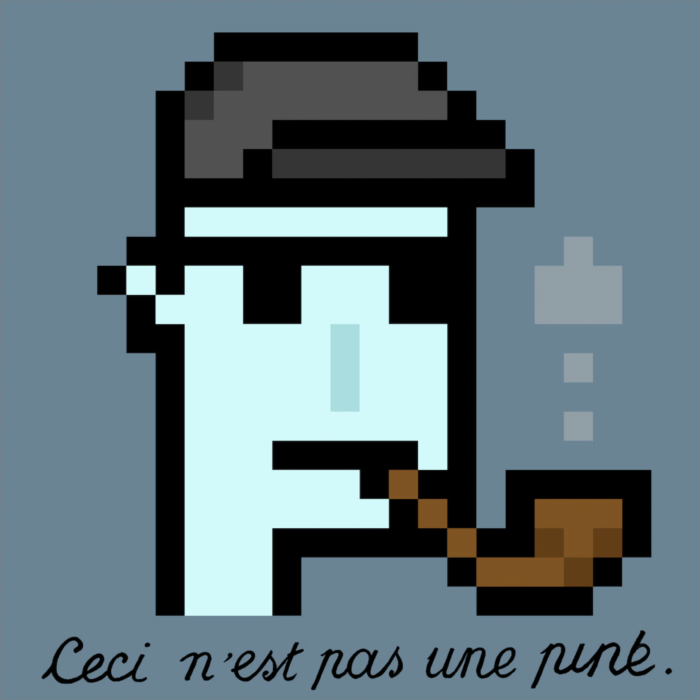
Kenny Schachter showed me another project, similar to mine: the CryptoPhunks, an entire clone of the Cryptopunk collection, 10000 images. They had a manifesto that shared more or less the same ideas behind my copy of CryptoPunk 3100. They also received a DMCA request, as I had, and I tried to help them, but being anonymous. They could answer to the notice and they were banned from OpenSea. The project kind of went dormant after that.
After this I had a conversation with Jeremy Cahen, a crypto investor and influencer that goes under the name of @Pauly0x on Twitter, also part of the CryptoPhunks community. That day we conceived the idea of creating a new marketplace. He wanted to create something, and I proposed him to create a marketplace that was a copy of Larva Labs and call it Not Larva Labs. To my surprise, two months later the project was actually created. I did really get involved with this community and I find Not Larva Labs philosophy a lot different from the corporate commercial NFT projects that are still pervasive to this day.
It was December 7 when I received a screenshot from a friend of mine, with a comparison between the BAYC logo and the Waffen Totenkopf logo. This brought me and other members of the community, Jeremy included, into a deep rabbit hole where we discovered a ton of nazi references embedded into the BAYC narrative and graphics. Anagrams and riddles, nicknames and inside jokes, all referring to the nazi, white supremacy and alt-right culture common among 4chan users, /pol/ in particularly, including the name of their company, Yuga Labs, which is blatantly referring to Kali Yuga, a popular element of alt right/traditionalist ideology, and the individual nicknames of the four founders: Gargamel (a character from the Smurfs and antisemetic depiction of a Jewish person), Gordon Goner (an anagram for Drongo Neg*o), Emperor Tomato Ketchup (from the avangarde Japanese film banned in some countries for child pornography, KKK and fascist iconographies), and SASS (as for SS + SA the two divisions of the Nazi army). The complete research is available at the website gordongoner.com, which I named in such a way so that it would be easier to find while searching for information about one of the BAYC founders. You can also find more details in the documentary video made by the YouTuber Philion.
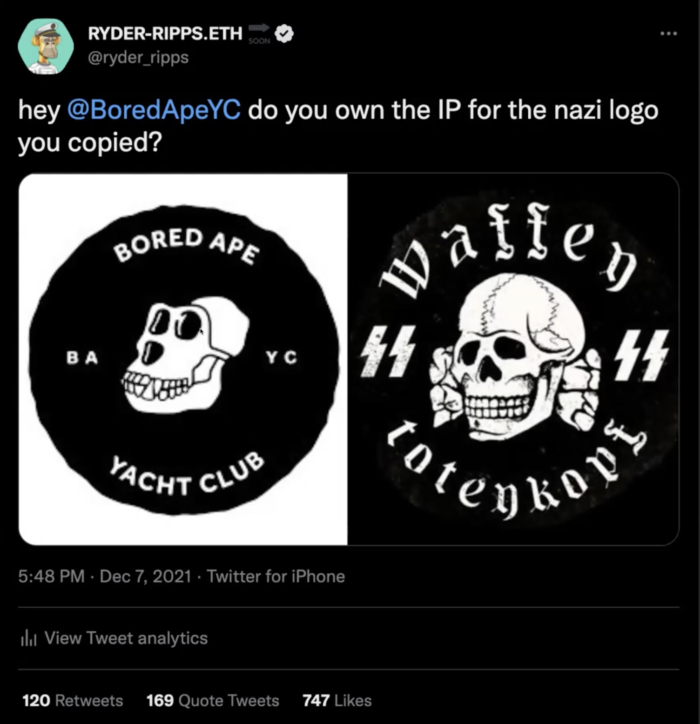
I published this research around January 2022, while BAYC and Yuga Labs by that time purchased cryptopunks and Meebits, buying the intellectual property of the then biggest NFT collection and basically creating a monopoly. A lot of the critique I made put into question the actual purpose and value of these images. 112 of these are identical, only the background is changing. And these are images that are theoretically sold with their intellectual property, and this means that if you buy these monkeys you can put it on a t-shirt, open a beer brand with that logo, but what are you buying if some of them are identical?
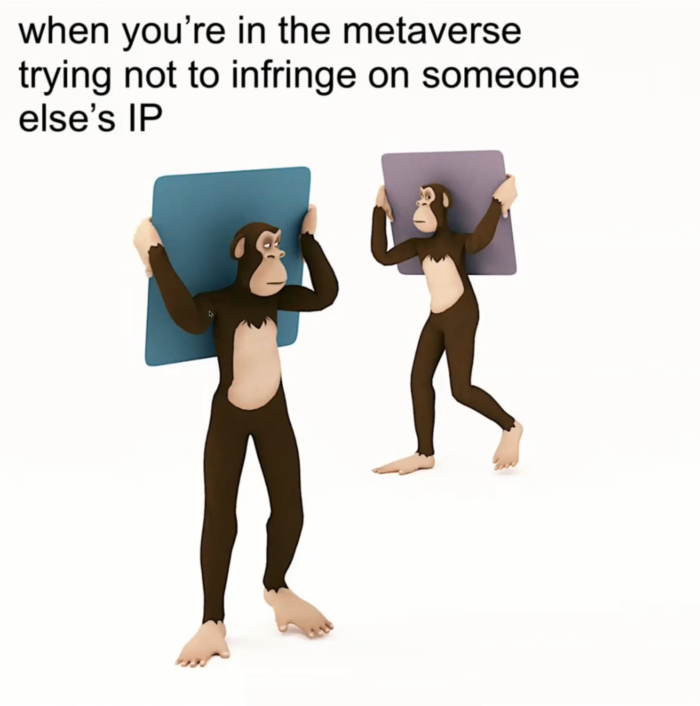
So I decided to continue with my provocation and I tweeted “If anyone wants a RR/BAYC ill mint you one for 0.1ETH send me the number”. The people who asked for one understood the provocation and wanted to be part of it. My replica called RR/BAYC, the Ryder Ripps BAYC, got so popular that BAYC sent a DMCA request to Foundation where the RR/BAYC was exposed.
Yuga Labs hit me and Jeremy Cahen with a lawsuits for false designation of origin, false advertising, cybersquatting, trademark infringement, unfair competition, and some other accusations, but they didn’t sue other BAYC replicas such BAYCTron or BabyApe. Obviously their attack is purely based on their desire to hurt us because of our speech. For this reason we responded with an anti-slapp (strategic lawsuit against public participation), the usual response to a lawsuit that is created with the desire to silence somebody.
As mentioned before, this is an abbreviated account of the great interventions that happened during the roundtable, Browsing Bottom-up Alternatives for Art on Web3, which can be followed in full in this video. After these interventions, it will be easier to understand why being an active or critical participant in the construction of Web3 should be considered crucial. Our actions are currently shaping the legal and economic aspect of what is appearing to be a far west, in the hands of a few, that will be used by many.
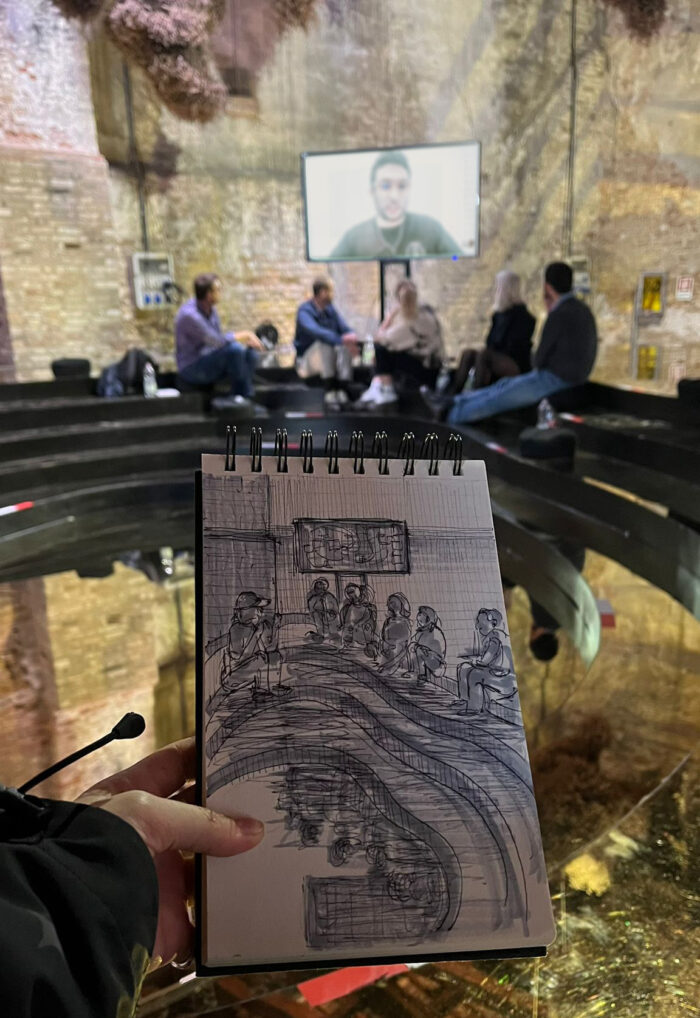
To leave us with some follow-ups, next month the superinternet.world project will be launched online. I would also like to suggest everyone to stream two conferences dealing with similar topics: Tactics & Practice #13: From COMMONS to NFTs, organized by Aksioma on November 12 and made available online, which, among others, is featuring talks by Denis “Jaromil” Roio and Puria Nafisi Azizi, two leading figures of Dyne.Org, interrogating on “how alternative crypto projects apply the concepts of radical, algorithmic and indigenous sovereignty in using the blockchain and NFTs with the aim to advance commoning practices”, and Creating with Blockchain, promoted by Fondazione Giangiacomo Feltrinelli in collaboration with Fondazione Fiera Milano and NERO Editions, to be held on November 22.




